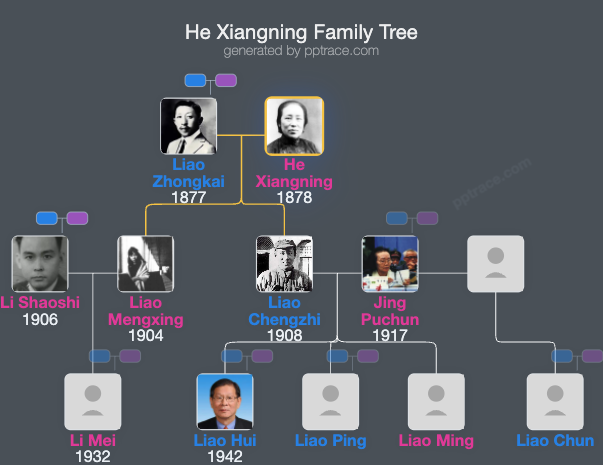
He Xiangning
| Name | He Xiangning |
| Title | Chinese woman politician and artist (1878-1972) |
| Gender | Female |
| Birthday | 1878-06-27 |
| nationality | People's Republic of China |
| Source | https://www.wikidata.org/wiki/Q8248830 |
| pptrace | View Family Tree |
| LastUpdate | 2025-02-28T08:50:46.847Z |
Introduction
He Xiangning (June 27, 1878 – September 6, 1972), courtesy name Ruijian, was a native of Nanhai, Guangdong. She was a renowned political activist, leader of the women's movement, and artist in modern China. Born into a business family in Hong Kong engaged in tea export and real estate, her father He Binghuan was from a farming background and came from a well-off family. In her early years, He Xiangning was of a strong-willed character with firm opinions, resisting the constraints imposed on women by tradition. At age seven, her family forcibly bound her feet; she snipped the binding cloth with scissors and cut her foot bindings, ultimately gaining freedom and becoming known for her "big feet."
She was a self-taught learner. As a young girl, she was unable to attend private schools and had to teach herself, consulting her elder brother for knowledge and gradually accumulating her education. In 1897, she married Liao Zhongkai, a returned overseas Chinese from Hong Kong, and afterward lived humbly and happily in the Liao family residence. During her studies in Japan, she supported her husband and attended several educational institutions, including the Girls' Normal School, Mejiro Girls' University in Tokyo, and the Honjō Art School in Tokyo, where she studied painting under the acclaimed Japanese artist Tanaka Raiho. In 1903, she met Sun Yat-sen in Tokyo, becoming acquainted with revolutionary ideas and actively participating in revolutionary activities. She published an article titled "My Dear Fellow Sisters," becoming one of the pioneers of the women's movement in China.
In 1904, pregnant, she returned to Hong Kong to give birth to her daughter Liao Mengxing. Afterwards, she dedicated her days to studying and her nights to revolutionary work, becoming an early member of the Tongmenghui (Chinese United League). In 1914, she joined the China Revolutionary Party, actively opposing Yuan Shikai and supporting the protect-the-constitution movement, working tirelessly under Sun Yat-sen’s leadership to promote national unification and republicanism. She served as the Minister of Women's Affairs for the Kuomintang, advocating for women's equality, promoting legislation to protect women's rights, and organizing activities such as International Women's Day, becoming an important figure in the Chinese women's liberation movement.
Throughout her revolutionary career, she played multiple roles—both as a political leader and as an artist. She used her brush to express patriotism; her works often featured flowers, birds, lions, and tigers, characterized by elegant and simple styles. Her artworks covered a broad range of themes with profound symbolism, and many became treasured classics. She was also the founder of He Xiangning Art Museum, China's first national art museum established under her personal name.
During the Anti-Japanese War, she organized women’s rescue teams to support the frontlines. After the victory in 1945, she firmly opposed Chiang Kai-shek’s civil war policy, actively participated in anti-Chiang movements. In 1928, she resigned from all positions within the Kuomintang and went into exile overseas, traveling through Southeast Asia and Europe, living a frugal life. After the outbreak of the war, she returned to China to organize women’s resistance efforts, founding the China Women's Anti-Japanese Aid Association and calling for national resistance against Japan.
After the founding of the People's Republic of China, she actively supported the Communist Party's leadership, participated in socialist construction, and held positions such as Vice Chairperson of the National Committee of the Chinese People's Political Consultative Conference and Chairwoman of the China Artists Association. She promoted overseas Chinese affairs and was concerned with women’s issues, arts, and diplomatic work, making outstanding contributions to national unification, liberation of the nation, and women’s rights. In 1972, due to her advanced age, she passed away in Beijing at the age of 95. She was buried beside Sun Yat-sen’s Mausoleum with high honors.
Family Tree
Tap to expand more relatives
